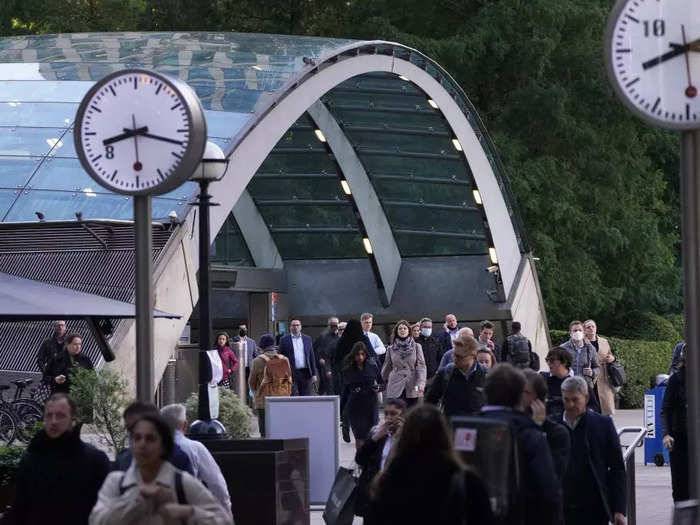Shutterstock
- Many workers have seen work-life balance undergo massive upheavals since the start of the pandemic in 2020.
- Experts have tried to explain a changing feeling about work with phrases like "quiet quitting."
This has been the year of workplace buzzwords.
Many people have seen their work-life balance undergo a massive upheaval since the start of the Covid-19 pandemic in 2020, leaving many workers and employees with whiplash.
"In the past, employers have had all of the cards. What's interesting now is salaries are going up, and benefits are going up," said S. Chris Edmonds, an executive consultant and CEO of the Purposeful Culture Group.
"Team members finally have a bit of power," he added.
However, in recent months, some of that power may have shifted back to employers, said Jessica Kriegel, chief scientist of workplace culture at Culture Partners.
Many workers are being asked to return to in-person work after years of working from home, while others fear impending layoffs. Experts say the wild swings in power dynamics have changed how employees feel about work in the US.
"One of the things I'm paying attention to is the ever-growing anti-work sentiment that seems to be happening," Kriegel said.
Experts and the press have tried to explain this changing feeling with alliterative phrases like "quiet quitting" and "career cushioning."
Kriegel said many phrases are "new ways of describing old dynamics."
Alexandra Levit, the author of "Deep Talent," echoed a similar idea.
"People have always been unhappy at work," she said. "But I think there has been an accelerated trend of burnout this year."
Here is a look back at some of the biggest workplace trends of 2022 and what experts say we should expect in 2023:
The Great Resignation
More and more burnt out employees are joining the Great Resignation. Audtakorn Sutarmjam/EyeEm via Getty Images
Employees started resigning from their jobs at an elevated rate late last year, and the trend shows no sign of slowing down. According to the latest data, 4.03 million Americans quit their jobs in October, down from September but still higher than pre-pandemic levels.
"Employees are voting with their feet and leaving jobs," Edmonds said.
"Over the two years of the pandemic, 100,000 or more US workers voluntarily quit. That's a significant number."
Quiet Quitting
Some managers fear that remote workers can easily get away with "quiet quitting." MoMo Productions/Getty Images
The term "quiet-quitting" took over TikTok – and the entire internet – earlier this year. It describes the act of doing the minimum requirements of a job, declining to go "above and beyond" your job's description.
While the phenomenon has reportedly freaked out some managers, Hannah Morgan, a job search strategist at Career Sherpa, applauds the movement.
"The fact that we have been asked to do so much more than what our job requires is not really fair to the employees," she said.
"I love the fact that employees are feeling empowered enough to say, 'I'm not gonna do a lot more than what my job requires.'"
Pay Transparency
Pay stub Getty Images
Beginning November 1, employers in New York City were required to post a salary range for open positions by a new salary transparency law. Colorado, Connecticut, and Nevada have similar laws, and a new law in California takes effect on January 1, 2023.
"Pay transparency is one of the greatest trends to have come out of 2022," Morgan said.
"It's forcing every organization to think about pay... it shouldn't be a secret," she added.
Labor Hoarding
Office workers in London. Getty Images
"Labor hoarding" is a new buzzy expression used by economists that suggest some companies are "hoarding" employees rather than conducting necessary layoffs due to the labor shortage.
However, layoffs have picked up recently in some industries, including tech and media.
"The way layoffs have been handled in most organizations has been bad," said Levit.
"I mean, we can talk about how we care about employees, and we care about their well-being and that we're dismayed that people are quiet-quitting, but at the end of the day, employers are treating them horribly when they let them go," she said.
Career Cushioning
Jessie Casson/Getty Images
"Career cushioning" is one of the newer terms to enter the workplace lexicon. It's a way to describe the tactic of developing a "Plan B" scenario in case of layoffs: searching for new jobs while still employed and brushing up skill sets and networks.
"I like to think of career cushioning as how people are positioning themselves so that they can be found for the next opportunity," Morgan said.
Kriegel said the rise in trendy phrases to describe workplaces in 2022 stems from the uncertainty people feel in their careers.
"The great resignation, quiet quitting, career cushioning, and others are emerging because people are trying to make sense of the sentiment that's out there and with so many mixed messages. It's shorthand for what we're feeling and thinking," she said.
What to expect in 2023
Rachel Mendelson/Insider
Workplace experts predict companies will have to do more for their employees to retain engaged talent in 2023.
"Companies will have to do a much better job defining career paths within the organization so that they can scoop up the right people and promote them into some of those harder-to-fill jobs," Morgan predicted.
Kriegel estimates that some companies will have to work to ensure their workers feel fulfilled in their careers.
"The trends in the new year will focus on purpose and mission. Purpose-driven organizations will be important because the disengaged worker will look for meaning in their work beyond just salary and benefits," she said.






